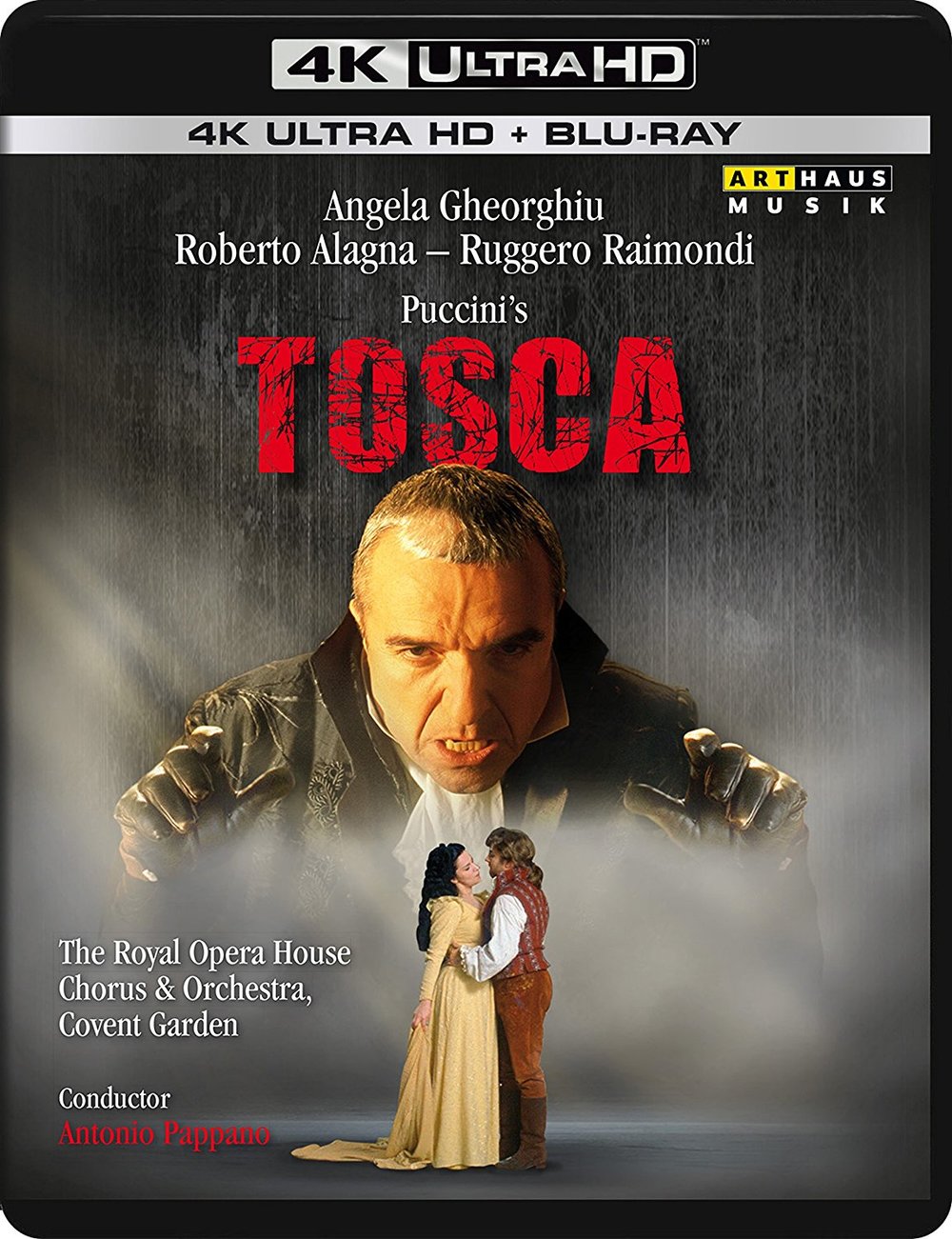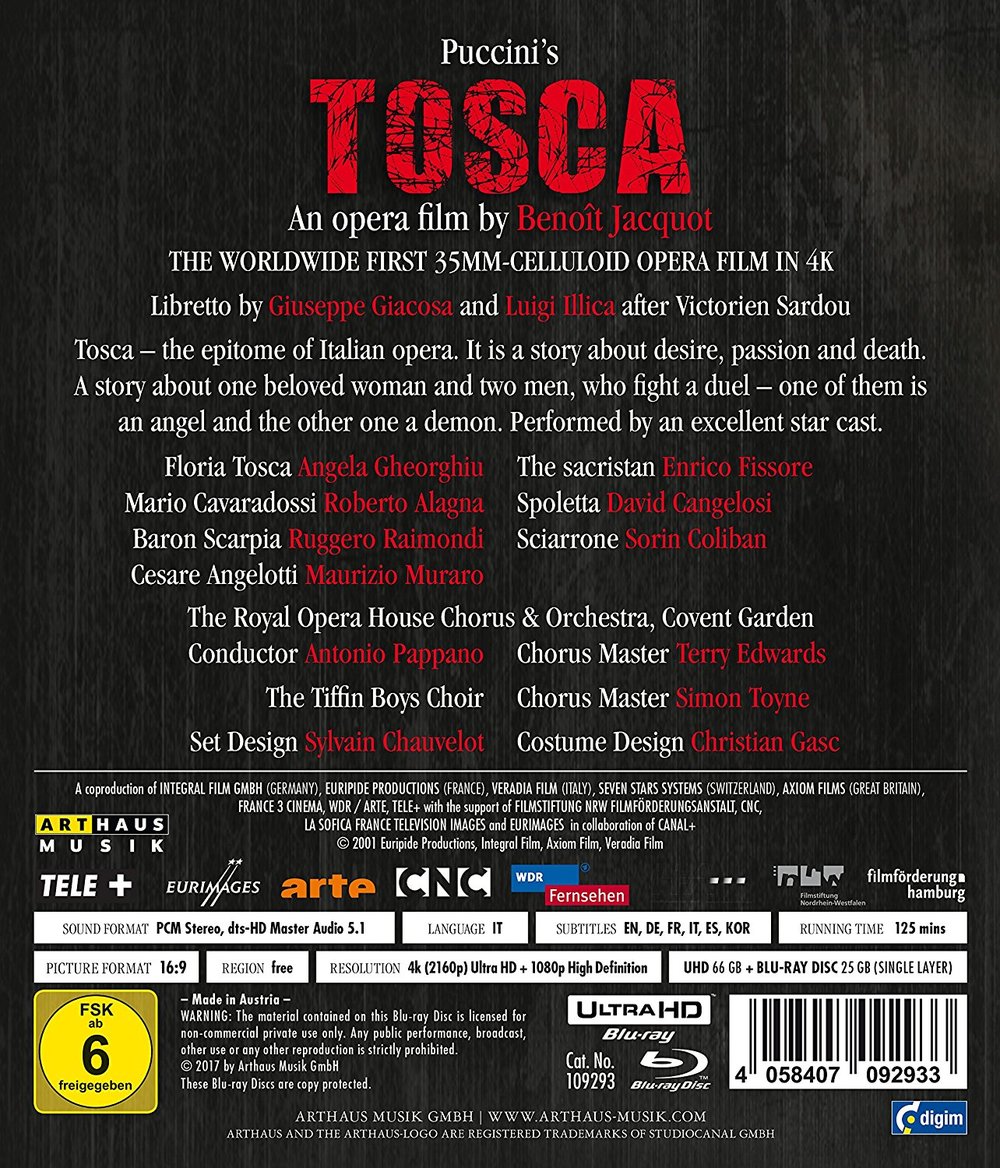

Puccini Tosca opera to libretto by Giuseppe Giacosa and Luigi Illica. Directed 2001 as a 35mm celluloid film opera movie by Benoît Jacquot at a movie studio in Germany. Stars Angela Gheorghiu [when she was young] (Floria Tosca), Roberto Alagna [then he was hot] (Mario Cavaradossi), Ruggero Raimondi [when he still looked scary] (Baron Scarpia), Maurizio Muraro (Cesare Angelotti), Enrico Fissore (Sacristan), David Cangelosi (Spoletta), and Sorin Coliban (Sciarrone). Antonio Pappano [when he was just getting started with the Royal Opera] conducts the Royal Opera House Orchestra, the Royal Opera Chorus (Chorus Director Terry Edwards), and The Tiffin Boys Choir (Chorus Master Simon Toyne). Set design by Sylvain Chauvelot; costume design by Christian Gasc. Released 2017, package includes 2 discs: a 2K (old fashioned) Blu-ray and a 4K Ultra HD Blu-ray. Please note this title does not have the High Dynamic Range (HDR) feature or any of the advanced sound technology available with the new 4K films. Sung in Italian. Released 2017, disc has 5.1 dts-HD Master Audio sound. Grade: A+
Jacquot is a major French movie director (some 40 films) who also loves opera. He did the mildly controversial Werther HDVD which we graded A+. Subject Tosca is the only movie shot on 35 mm film before 2008 (the advent of HD TV generally) that is good enough to benefit from Blu-ray presentation and therefore qualifies to be covered on this website.
The music and singing for Jacquot's Tosca opera movie was recorded first. Then the singers acted out their parts singing as the movie cameras rolled. The movie was made in a studio—there is no stage and no natural locations are visited by singers. The sets and props are sumptuously conceived but surrounded by an utterly black and empty universe in the background. Act 1 is in a church as seen (in part) below:
Act 2 plays out in the palace of Scarpia, the police chief:
And in Act 3 we see here Tosca at the prison:
Jacquot has his own agenda in making movies and is not much concerned with the idea of maintaining a suspension of disbelief. As result there are many unexpected aspects of the recording to keep you on your toes. For example, natural locations (interior and exterior) are shown throughout the film, but always in a strangely colored and grainy mode shot from a hand-held camera:
The director shifts often to primitive B&W images—this is an art movie, not an opera production:
The film is further full of motion-picture tricks like, as seen next below, extreme manipulation of depth-of-field-of-focus:
Or physically surprising views like the aerial angle below:
Jacquot likes cozy head-shots with dramatic lighting as seen in the next two screenshots:
And you can't get a view like this from the back row of the top balcony:
Other tricks include (but are not limited to) flashbacks, running film backwards, and letting certain passages in the libretto be heard when the actors’ mouths don’t move because they are singing the passages in their minds! So what is Jacquot up to here with all these tricks? Well, here's the answer in his own words (quoted from our Werther story):
“When I make a film, for me the whole thing stems from the actors who are going to inhabit it. The aim of all the gestures, pacing and blocking, momentum, repose, sets, costumes, and lighting was to give the singers the sort of presence that makes it impossible not to believe what they are expressing, just as they truly believe what they are singing. In any case, these wonderful singers are also excellent actors, interpreters of a music that, quite apart from its subtleties, asked for the simple, uncluttered truth, in all its pathos. It is for you to hear, and to see.”
The presence of the actors is what makes you believe. And in this opera, and this recording, the actor who leads us believers into the cataclysm is Scarpia, chief of police:
Is Scarpia the greatest example in all literature of the corrupt chief of police? Every time I watch Jacquot's Tosca, I think of how accurately Giacosa and Illica foretold of the priapic Latvia Beria, Stalin's most fearful policeman, the rapist and killer of countless women and girls who were the wives and daughters of enemies of the people. Here next below we see Scarpia's face reflected in the blade of his steak knife as he confesses:
And professes:
And now Tosca is the prey:
Jacquot is unbelievably skilled at getting his singers to act like they are seasoned movie stars. And the directing is truly realistic: this is the only Tosca HDVD (of 7 in January 2020) that follows the libretto and has Tosca planting the steak knife directly into Scarpia’s heart (rather than in his midriff). Next below is the end of Act 2 when Tosca flees the palace as soon as possible after confirming that Scarpia is dead:
It seems Jacquot believes that opera is a "hot" art. First you have the orchestral reacting like a jungle cat to everything happening in the libretto. Then you have everyone singing instead of talking. Ideally the singers look good in their roles; and with Jacquot, they learn to accept direction and act. That's enough molecular motion. If you have elaborate sets, costumes, and lighting as well, Jacquot feels the production can overheat and melt. So he surrounds the action with cooler elements that act as foils to focus attention on his stars living out their roles. And once he gets this going, there's no stopping for an intermission!
The trio of Gheorghiu, Alagna, and Raimondi is unsurpassed in any other Tosca HDVD as to singing and acting skills combined. And Gheorghiu and Alagna are the only pair in our HDVDs who are young and beautiful enough to be completely convincing as lovers.
The music is excellent in surround sound with sumptuous playing from the orchestra that exactly supports the players and the libretto while never overwhelming the singing line. The English subtitles are fine. And the Arthaus package is generous with both the 2K and 4K versions.
Now for a grade. Jacquot’s film isn’t perfect. The 35 mm camera images are slightly washed out in the early scenes, there is considerable motion judder early in the recording, and some of Jacquot’s art-house movie techniques take time to adjust to. But this title is singular in the entire history of recordings of classical music in its combination of fine orchestra playing, great chorus work, cogent stage direction, and fantastically good acting by fully qualified, world-class opera singers. It shows us what we could look forward to in the future if expert movie directors are given the resources to make good HDVDs of the opera canon. A+
OR

















